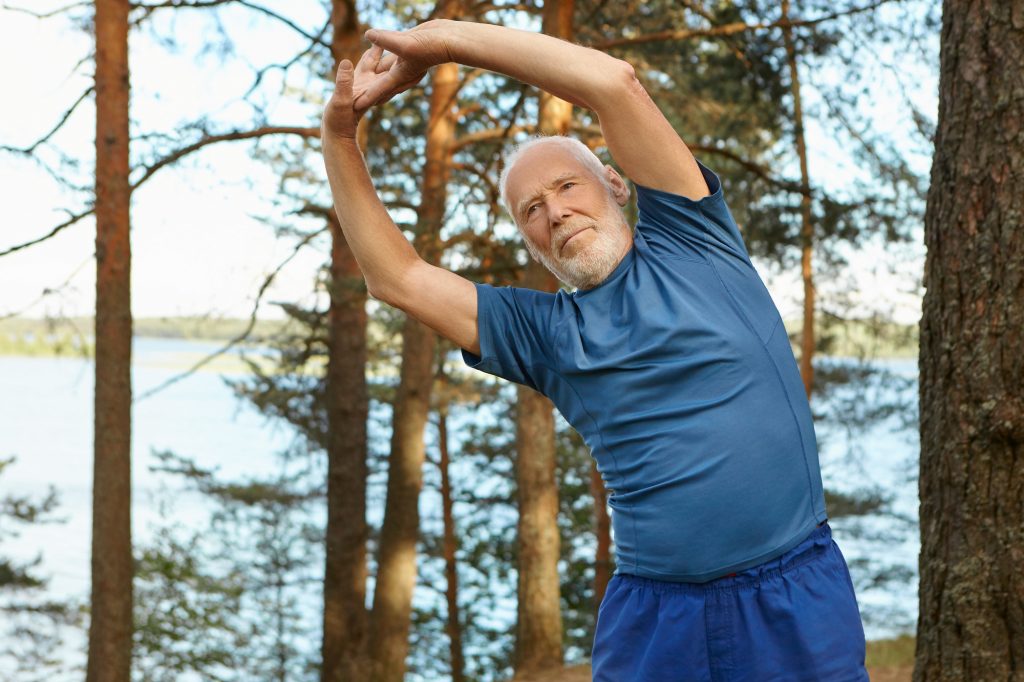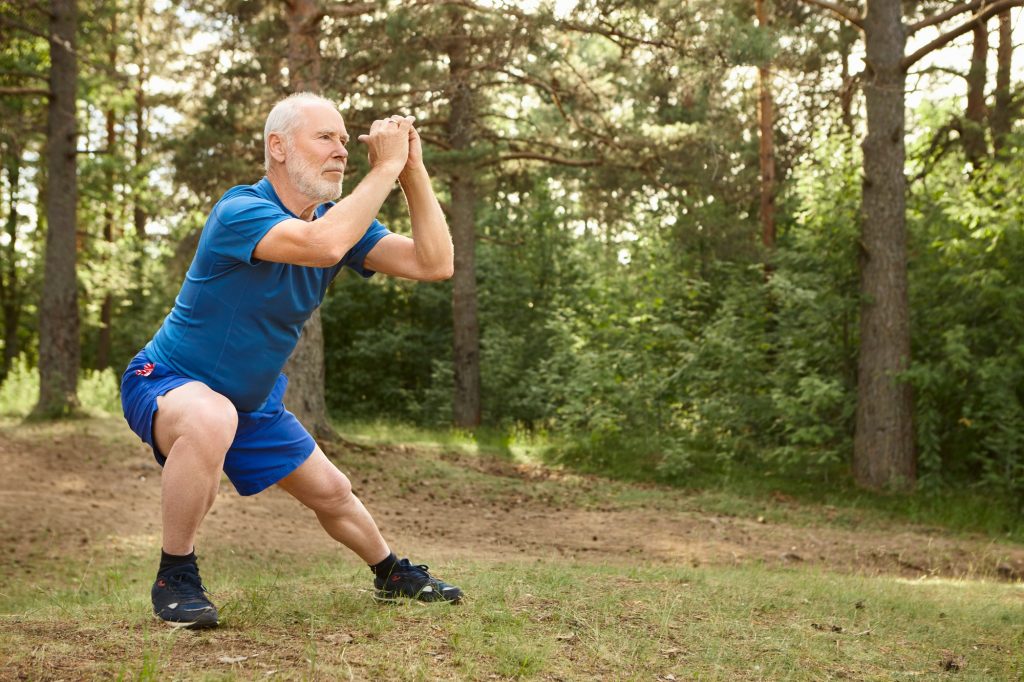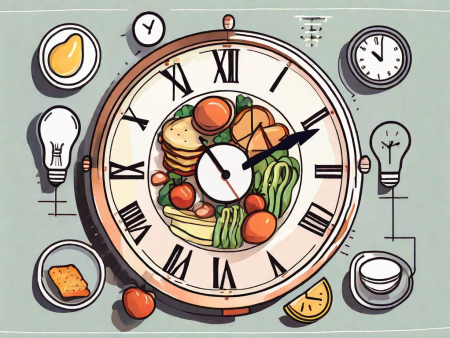Discover the numerous benefits of aerobic exercises for older men.
The Benefits of Aerobic Exercises for Older Men

As men get older, it becomes increasingly important to prioritize their health and well-being. One way to achieve this is through regular exercise, specifically aerobic exercises. Aerobic exercises, also known as cardio exercises, are activities that increase heart rate and breathing for an extended period. These exercises offer a myriad of benefits for older men, both physically and mentally.
Understanding Aerobic Exercises
Before delving into the benefits, it’s vital to understand what aerobic exercises entail. Simply put, aerobic exercises are activities that get your heart pumping and your blood flowing. They include activities like walking, jogging, swimming, and cycling. These exercises increase oxygen flow to the muscles, enhancing cardiovascular fitness and overall health.
Aerobic exercises have been a popular form of physical activity for decades. They offer numerous benefits for individuals of all ages and fitness levels. Whether you’re a beginner or an experienced athlete, incorporating aerobic exercises into your routine can have a significant impact on your overall well-being.
Definition and Types of Aerobic Exercises
Aerobic exercises are characterized by their ability to increase heart rate and engage large muscle groups continuously. Some common types of aerobic exercises include brisk walking, running, dancing, aerobics classes, and swimming. These exercises can be performed individually or in groups, indoors or outdoors, depending on personal preferences and accessibility.
Brisk walking is an excellent low-impact aerobic exercise that can be easily incorporated into your daily routine. It requires no special equipment and can be done anywhere, making it a convenient choice for many individuals. Running, on the other hand, is a high-impact aerobic exercise that provides a more intense cardiovascular workout. It helps build endurance and strengthens the lower body muscles.
Dancing is not only a fun and enjoyable activity but also a great way to get your heart rate up. Whether it’s salsa, hip-hop, or ballet, dancing engages multiple muscle groups and improves coordination and balance. Aerobics classes, often offered at fitness centers, provide a structured and energetic workout that combines various aerobic exercises to keep you motivated and challenged.
Swimming is a low-impact aerobic exercise that offers a full-body workout. It is gentle on the joints, making it an ideal choice for individuals with joint pain or injuries. Swimming engages both the upper and lower body muscles, improving strength and endurance while also providing a refreshing and invigorating experience.
The Science Behind Aerobic Exercises
Engaging in regular aerobic exercises has a positive impact on various physiological systems in the body. These exercises increase the heart rate, which strengthens the heart muscle and improves its efficiency. Regular aerobic exercise also improves lung function, allowing for better oxygen intake and carbon dioxide removal. Additionally, aerobic exercises promote the release of endorphins, which are neurotransmitters that boost mood and reduce stress.
When you engage in aerobic exercises, your heart pumps faster, delivering oxygen-rich blood to your muscles. This increased blood flow improves the efficiency of your cardiovascular system, making it more capable of meeting the demands of physical activity. Over time, regular aerobic exercise can lead to a stronger and more resilient heart.
Furthermore, aerobic exercises improve lung function by increasing the depth and frequency of your breaths. This allows for better oxygen intake and efficient removal of carbon dioxide, resulting in improved respiratory health. Whether you’re walking briskly or swimming laps, these activities challenge your lungs and help them become more efficient at supplying oxygen to your body.
Another significant benefit of aerobic exercises is their impact on mental well-being. When you engage in these activities, your brain releases endorphins, which are often referred to as “feel-good” chemicals. Endorphins help reduce stress, alleviate anxiety, and boost mood. This is why many people experience a sense of euphoria or a “runner’s high” after a vigorous aerobic workout.
Moreover, regular aerobic exercise has been shown to improve sleep quality, enhance cognitive function, and reduce the risk of chronic diseases such as heart disease, diabetes, and obesity. It can also help manage weight by burning calories and increasing metabolism.
In conclusion, aerobic exercises offer a wide range of benefits for both the body and mind. From improving cardiovascular fitness and lung function to boosting mood and reducing the risk of chronic diseases, incorporating aerobic exercises into your routine can have a transformative impact on your overall health and well-being.
The Importance of Exercise in Aging
Aging is a natural part of life, and with it comes changes in both physical and mental health. Incorporating exercise into the daily routine of older men can help mitigate some of these challenges and improve overall well-being.
As men age, they may experience a gradual decline in muscle mass and bone density, making them more prone to injuries and chronic conditions like osteoporosis. Regular exercise, particularly aerobic exercises, can help counteract this decline by preserving and building muscle mass and improving bone density. It also enhances balance and coordination, reducing the risk of falls and fractures.
In addition to the physical benefits, exercise also has profound effects on mental well-being. Engaging in regular aerobic exercises can alleviate symptoms of anxiety, depression, and stress. It releases endorphins, often referred to as “feel-good” hormones, which boost mood and promote a sense of relaxation and happiness. Additionally, exercise improves cognitive function, memory, and sleep quality in older men.
Furthermore, exercise plays a crucial role in maintaining cardiovascular health. Regular physical activity helps lower blood pressure, reduce the risk of heart disease, and improve overall cardiovascular function. It increases the efficiency of the heart and lungs, allowing for better oxygen delivery to the body’s tissues and organs.
Another benefit of exercise in aging is its positive impact on weight management. As metabolism naturally slows down with age, it becomes easier to gain weight and harder to lose it. Regular exercise helps boost metabolism, burn calories, and maintain a healthy weight. It also helps prevent the accumulation of visceral fat, which is associated with an increased risk of chronic diseases such as diabetes and heart disease.
Exercise is not only beneficial for physical and mental health but also for social well-being. Participating in group exercise classes or engaging in physical activities with friends and family can provide opportunities for social interaction and support. This social aspect of exercise can help combat feelings of loneliness and isolation that are common among older adults.
Moreover, exercise has been shown to have a positive impact on the immune system. Regular physical activity can enhance immune function, reducing the risk of infections and diseases. It also promotes the production of antibodies and immune cells, which play a crucial role in defending the body against pathogens.
Lastly, exercise has been linked to a reduced risk of age-related cognitive decline and neurodegenerative diseases such as Alzheimer’s. Physical activity stimulates the growth of new neurons and strengthens existing neural connections, improving brain health and cognitive function. It also enhances blood flow to the brain, delivering oxygen and nutrients necessary for optimal brain function.
Specific Benefits of Aerobic Exercises for Older Men
Now let’s dive into the specific benefits that aerobic exercises offer for older men.
Cardiovascular Health and Aerobic Exercise
One of the significant benefits of aerobic exercises is their positive impact on cardiovascular health. Regular aerobic exercise strengthens the heart muscle, improving its ability to pump blood efficiently. This reduces the risk of cardiovascular diseases, such as heart attacks and strokes. It also helps manage and control conditions like high blood pressure and high cholesterol levels.
In addition to these benefits, aerobic exercise also improves the overall health of blood vessels. When you engage in aerobic activities, your blood vessels expand and contract more efficiently, promoting better blood flow throughout your body. This enhanced blood circulation ensures that all your organs receive an adequate supply of oxygen and nutrients, which is crucial for their optimal functioning.
Furthermore, aerobic exercise stimulates the production of nitric oxide in the body. Nitric oxide is a powerful vasodilator, meaning it relaxes and widens blood vessels, leading to improved blood flow. This not only reduces the workload on the heart but also enhances the delivery of oxygen and nutrients to your muscles, promoting their health and endurance.
Aerobic Exercise and Bone Health
As mentioned earlier, aging can lead to a decrease in bone density, making older men more susceptible to fractures and osteoporosis. However, engaging in weight-bearing aerobic exercises, such as walking or jogging, stimulates bone growth and helps maintain bone density. This, in turn, reduces the risk of fractures and improves overall bone health.
When you perform weight-bearing aerobic exercises, the impact and stress placed on your bones stimulate the cells responsible for bone formation, called osteoblasts. These cells become more active, leading to increased bone density and strength. Additionally, aerobic exercise also enhances the absorption of calcium and other essential minerals needed for bone health.
Moreover, aerobic exercise promotes better balance and coordination, which are crucial for preventing falls and related injuries in older men. By improving muscle strength and flexibility, aerobic exercises help maintain stability and reduce the risk of accidents.
Aerobic Exercise for Weight Management
Weight management becomes more challenging as men age due to slowed metabolism and muscle loss. Regular aerobic exercises help burn calories, maintain a healthy weight, and increase muscle mass. This not only aids in weight management but also reduces the risk of obesity-related diseases, including diabetes, heart disease, and certain types of cancer.
When you engage in aerobic activities, your body’s energy expenditure increases, leading to the burning of calories. This calorie deficit is essential for weight loss or weight maintenance. Additionally, aerobic exercise also helps preserve and build lean muscle mass, which is crucial for a healthy metabolism.
Furthermore, aerobic exercise has been shown to improve insulin sensitivity, which is the body’s ability to use insulin effectively. This is particularly important for older men as insulin resistance is a common issue with aging. By improving insulin sensitivity, aerobic exercise helps regulate blood sugar levels and reduces the risk of developing type 2 diabetes.
Lastly, aerobic exercise has a positive impact on mental health, which is often overlooked. Regular physical activity releases endorphins, also known as “feel-good” hormones, which can help reduce stress, anxiety, and symptoms of depression. This, in turn, improves overall well-being and quality of life.
Safety Measures and Precautions for Older Men
While aerobic exercises offer numerous benefits, it’s crucial for older men to take necessary safety measures and precautions when starting or maintaining an exercise routine.
Starting an Exercise Routine Safely
Prior to starting any exercise routine, it’s advisable for older men to consult a healthcare professional. They can provide guidance based on individual health conditions and create a suitable exercise plan. It’s also essential to start slowly and gradually increase the intensity and duration of workouts to avoid overexertion and potential injuries.
Recognizing and Avoiding Overexertion
Pushing oneself too hard during exercise can lead to overexertion and other adverse effects. Older men should pay attention to their bodies and avoid surpassing their physical limitations. Taking breaks, staying hydrated, and listening to the body’s signals can help prevent overexertion and ensure a safe and enjoyable exercise experience.
Incorporating Aerobic Exercises into Daily Routine
Now that we’ve outlined the benefits and safety measures, let’s explore practical ways for older men to incorporate aerobic exercises into their daily routine.

Choosing the Right Aerobic Exercise
When selecting aerobic exercises, it’s crucial to choose activities that align with personal interests, physical capabilities, and accessibility. This ensures that the exercise routine is enjoyable and sustainable in the long run. Whether it’s swimming laps, going for a brisk walk, or joining a dance class, finding a preferred activity increases motivation and adherence to the exercise plan.
Setting a Sustainable Exercise Schedule
Establishing a consistent exercise schedule is key to making it a regular part of daily life. Older men may find it helpful to set specific days and times for aerobic exercises, allowing for other commitments and ensuring they have dedicated time for physical activity. Partnering with a friend or joining a group exercise class can also provide accountability and make the experience more enjoyable.
In conclusion, aerobic exercises offer numerous benefits for older men. Not only do they improve cardiovascular health and promote weight management, but they also positively impact bone health and mental well-being. By taking necessary precautions and incorporating these exercises into their daily routine, older men can enhance their overall health, vitality, and quality of life. So, put on those sneakers, turn up the music, and get ready to embark on a rewarding exercise journey!







